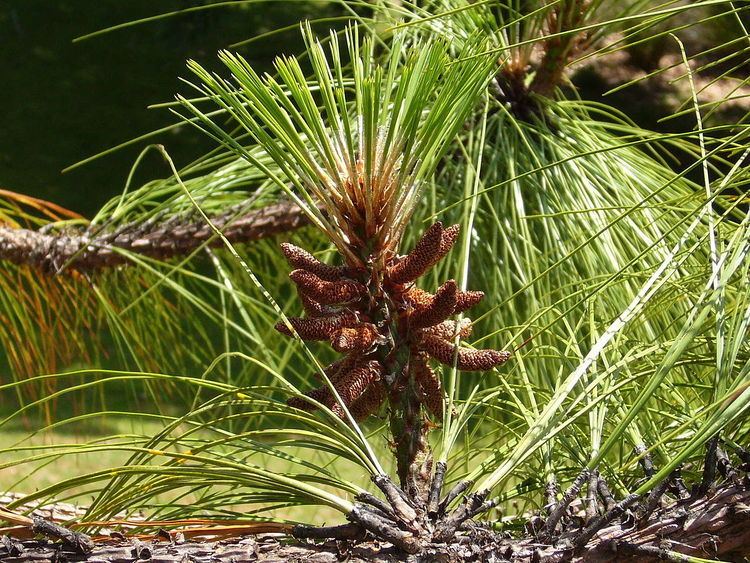 | ||
Mexican conifers extend mainly in the main mountain ranges: Sierra Madre Oriental, Sierra Madre Occidental and the Trans-Mexican Volcanic Belt. Enclosed between these mountains there are disperse groups of conifers in mid and high elevations valleys when rainfalls conditions allow its growth. Mexican conifers grow in some places associated with oaks.
The dry season is about 7–8 months. Most of rainfalls (80-95%) occur from June to October (5 months) and only four months in the north. Precipitations throughout the year are present only in a little portion of the Sierra Madre Oriental in the State of Veracruz. The greatest number of species belong the Pinus genus, being about 60 the number of species and subspecies.
Among trees that grow in subtropical climates: Pinus chiapensis, Pinus oocarpa, pinus tecunumanii
Among the trees that grow in temperate and cool climates:
Pinus ayacahuite, Pinus cembroides, Pinus durangensis, Pinus engelmanii, Pinus greggii, Pinus hartwegii, Pinus leiophylla, Pinus lumholtzii, Pinus devoniana, Pinus montezumae, Pinus nelsonii, Pinus oocarpa var. trifoliata, Pinus patula, Pinus pseudostrobus, Pinus hartwegii, Pinus rudis, Pinus teocote, Taxodium mucronatum, Abies religiosa and Cupressus lusitanica.
Among trees that grow in exclusively in cool climates: Pinus hartwegii, Pinus rudis.
Cultivation and uses
Some of the trees are cut off locally for their wood which is used mainly in boards, construction, rustic furniture and in paper production. Resin is extracted from some species. And there are some trees that are estimated by its seeds: Pinus nelsonii, Pinus maximartinezii, Pinus cembroides and Pinus orizabenzis.
The conifers of Mexico have been recently started to be introduced in different parts around the world and their plantations are considered as very important. The leading reasons for that expansion is the good quality that their wood has for paper production but they are also planted as ornamental due to their unique characteristics and exotic beauty. The main genus used with that purposes are: pines, cypresses and firs and taxodiums.
In their natural environment they grow from 30° to 14° North Latitude. At altitudes between 600 to 4300 meters above sea level. And there are some advantages for their introduction in several places at different altitudes latitudes and climates: The average rainfalls in which they occur fluctuate between 380 to 2000 millimeters a year. Above 2400 m in elevation snowfalls are usual. Moist conditions vary from a short season of rainfalls in summer to a climate with rainfalls throughout the year, and can develop from semiarid to very wet conditions. In general they can withstand dry summers and some of are drought tolerant in several degrees. They grow from subtropical to cool climates; the average temperatures varies from 24 °C to 10 °C. Some of them are surprisingly hardy (Pinus hartweggi, Pinus rudis, Pinus ayacahuite; etc.) tolerating temperatures as low as –30 °C. These trees occur as in very tilt slopes and plain valleys.
Mexican conifers from temperate and cool climates that are being cultivated in other countries for paper industry according to altitudinal, latitudinal and climatic characteristis:
Near or in the Equator line at high altitudes:
Pinus leiophylla in Kenya. Pinus montezumae in Kenya. Pinus ayacahuite in Kenya, Tanzania, Cupressus lusitanica in Colombia where it is used for creating windbreaks curtains in mountain slopes and fighting against soil erosion. Pinus greggi in Colombia. Pinus patula in Ecuador (3500 m), Colombia (3300 m), Kenya, Tanzania, Papua New Guinea.
In tropical latitudes at high altitudes:
Pinus leiophylla in Malawi, Zimbabwe, Zambia. Pinus montezumae in Malawi, Botswana and Zimbabwe. Pinus ayacahuite in Angola. Pinus greggi in Zimbabwe and Bolivia. Pinus patula in Bolivia, Zimbabwe, Angola, Hawaii. Cupressus lusitanica in Bolivia
In Subtropical latitudes at mid and high altitudes:
Pinus leiophylla in South Africa and Queensland, Australia. Pinus montezumae in South Africa and Queensland, Australia. Pinus cembroides in South Africa (produces edible nuts) Pinus ayacahuite in Southern Brazil and Northern India, Northern Argentina in Salta and Tucumán Provinces. Cupressus lusitanica in South Africa. Pinus greggi in South Africa and Southern Brazil. Pinus patula in South Africa, Northern India and Southern Brazil
Mexican conifers from subtropical climates that are being planted in tropical and subtropical latitudes at low and mid altitudes for paper industry:
Pinus oocarpa in Ecuador, Kenya, Zambia, Colombia, Bolivia, Brazil, South Africa and Queensland, Australia. Pinus chiapensis in Colombia, Brazil, Queensland, Australia and South Africa. Pinus tecunumanni Colombia, Brazil, Queensland, Australia and South Africa.
Mexican conifers from temperate and cool climates and from mid and high altitudes that are being cultivated near sea level for paper industry:
New Zealand has been a pioneer country in cultivating massively trees from high altitudes and tropical latitudes and it has proved that Mexican conifers can thrive in big extensions near sea level when temperature and rainfall conditions are favorable. Most of this species are fully naturalized. Mexican conifers planted in New Zealand are:
Cupressus lusitanica, Pinus ayacahuite, Pinus devoniana, Pinus patula, Pinus pseudostrobus, Pinus montezumae
Mexican conifers that have been planted with forestation purposes at temperate latitudes at mid and low altitudes:
Pinus patula and cupressus lusitanica in the Argentine provinces of Córdoba and San Luis at lower altitudes than its origin site but with a similar temperate climate with rainfalls in summer.
Mexican conifers from mid and high altitudes that have been planted as ornamental at temperate latitudes near sea level:
Cupressus lusitanica in the United Kingdom; Austin, Texas; Buenos Aires, Argentina and Northern Portugal, Pinus ayacahuite in the United Kingdom, Pinus devoniana in France, Pinus hartweggi in the United Kingdom, Pinus montezumae in southern New South Wales, Australia
